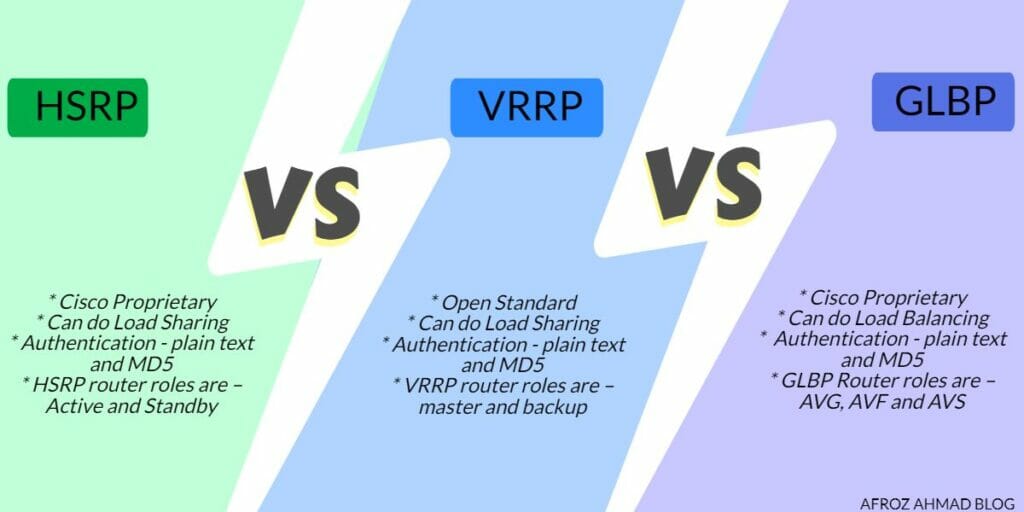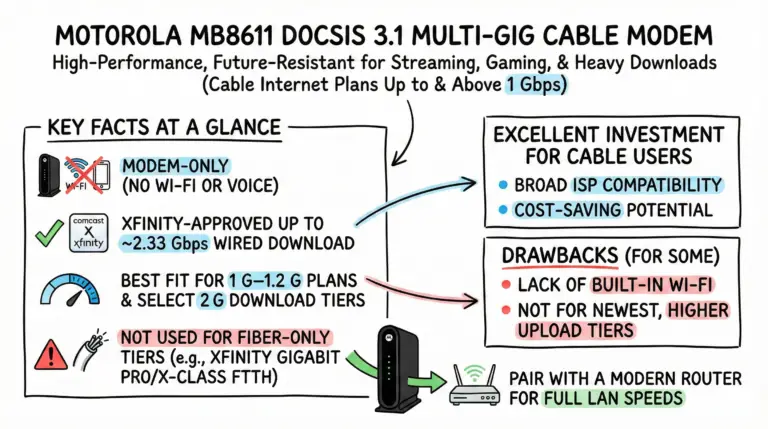Deciding between HSRP vs. VRRP vs. GLBP is a common challenge for network engineers. The right choice often depends on your network equipment, design goals, and specific redundancy requirements. All three are First Hop Redundancy Protocols (FHRPs) that operate at the network layer to prevent a single point of failure for the default gateway in a network.
The most fundamental difference is that VRRP is an open standard, making it compatible with a wide range of vendors. HSRP and GLBP, on the other hand, are Cisco-proprietary protocols. While HSRP and VRRP are designed to make a single router active for a given group, GLBP was created to allow for active-active load balancing. However, the networking landscape has evolved significantly since these protocols were first introduced.
Historically, GLBP was recommended for load balancing across multiple gateways. However, in modern network designs, GLBP is considered a legacy protocol. For new deployments, technologies like switch stacking (for campus networks) or vPC/EVPN (for data centers) provide more robust and integrated redundancy and load balancing, and are the current best practice. This guide will help you understand the original purpose of each protocol and where they fit in today’s networks.

HSRP vs. VRRP vs. GLBP: Comparison Table
Here is a detailed breakdown of the key similarities and differences between these three essential redundancy protocols.
| Feature | HSRP (Hot Standby Router Protocol) | VRRP (Virtual Router Redundancy Protocol) | GLBP (Gateway Load Balancing Protocol) |
|---|---|---|---|
| Vendor Support | Cisco Proprietary | Open Standard (IETF RFC 5798) | Cisco Proprietary |
| Load Balancing | No native load balancing. Can be achieved by configuring multiple groups. | No native load balancing. Can be achieved by configuring multiple groups. | Yes, provides true load balancing for up to 4 routers per group. |
| Router Roles | 1 Active, 1 Standby, multiple Listeners | 1 Master, multiple Backups | 1 Active Virtual Gateway (AVG), up to 4 Active Virtual Forwarders (AVFs) |
| Versions & Key Features | v1 (legacy), v2 (adds IPv6 support, ms timers, expanded group range) | v2 (IPv4 only), v3 (adds IPv6 support) | One primary version. Now considered legacy. |
| Preemption | Disabled by default. Allows a higher-priority router to take over the active role. | Enabled by default. Allows a higher-priority router to take over the master role. | Enabled by default. |
| Virtual MAC Address | 0000.0C07.ACxx (where xx is the group number) | 0000.5E00.01xx (where xx is the group number) | 0007.B400.xxyy (xx=group, yy=forwarder) |
| Timers | Hello: 3s, Hold: 10s (configurable, including millisecond timers in v2) | Hello: 1s, Hold: 3s (configurable) | Hello: 3s, Hold: 10s (configurable) |
| Modern Relevance | Widely used in Cisco-only campus and branch networks. | Widely used in multi-vendor environments. | Legacy. Superseded by modern technologies. |
Modern Alternatives to First Hop Redundancy
While FHRPs are still relevant, especially in traditional campus and branch networks, modern designs often use more integrated solutions for redundancy and load balancing.
- Switch Stacking (e.g., Cisco StackWise): In campus networks, stacking multiple physical switches into a single logical unit provides a redundant forwarding path. If one switch fails, traffic continues to flow through the remaining members of the stack without the need for a separate gateway failover protocol.
- vPC and EVPN VXLAN: In the data center, technologies like Virtual Port-Channel (vPC) allow a server to connect to two different switches that appear as a single logical switch. For larger-scale networks, EVPN VXLAN provides advanced Layer 2 and Layer 3 overlay networking, offering superior redundancy, scalability, and mobility compared to traditional FHRPs.
Basic Configuration Examples (Cisco IOS)
Here are some simple configuration snippets to illustrate how each protocol is set up on a Cisco router interface.
HSRP Configuration
interface GigabitEthernet0/1
ip address 192.168.1.2 255.255.255.0
standby version 2
standby 1 ip 192.168.1.1
standby 1 priority 110
standby 1 preemptVRRP Configuration
interface GigabitEthernet0/1
ip address 192.168.1.2 255.255.255.0
vrrp 1 ip 192.168.1.1
vrrp 1 priority 110GLBP Configuration
interface GigabitEthernet0/1
ip address 192.168.1.2 255.255.255.0
glbp 1 ip 192.168.1.1
glbp 1 priority 110
glbp 1 load-balancing round-robinDefinitions and Acronyms
- FHRP: First Hop Redundancy Protocol
- HSRP: Hot Standby Router Protocol
- VRRP: Virtual Router Redundancy Protocol
- GLBP: Gateway Load Balancing Protocol
- AVG: Active Virtual Gateway (GLBP)
- AVF: Active Virtual Forwarder (GLBP)
- ARP: Address Resolution Protocol
Conclusion
In this post, we looked into the similarities and differences between HSRP, VRRP, and GLBP. While all three provide gateway redundancy, your choice depends heavily on your environment. VRRP is the go-to for multi-vendor networks, while HSRP remains a solid choice for Cisco-only setups. GLBP, while innovative for its time, has largely been replaced by more modern and robust technologies for load balancing and high availability.
If you liked this post, please share it to reach out to other people who might be searching for the same topic.
Frequently Asked Questions
When should I use HSRP instead of VRRP?
You should use HSRP when you are in a Cisco-only network environment and need access to Cisco-specific features, such as enhanced object tracking. VRRP is the better choice for multi-vendor networks, as it is an open standard and ensures interoperability between different manufacturers’ equipment.
Can HSRP and VRRP perform load balancing?
Not natively. Both HSRP and VRRP are designed for active/standby redundancy, where only one router is forwarding traffic for a group at any time. However, you can achieve a form of load sharing by configuring multiple groups and making different routers active for different groups. For example, Router A can be active for VLAN 10, while Router B is active for VLAN 20.
Why is GLBP considered a legacy protocol?
GLBP is considered legacy because modern network architectures offer more efficient and scalable methods for redundancy and load balancing. Technologies like switch stacking in campus networks and vPC or EVPN in data centers integrate high availability directly into the network fabric, eliminating the need for a separate gateway protocol and providing superior performance and simpler management.
- TP-Link TL-SG108E vs Netgear GS308E: Budget Smart Switches - January 5, 2026
- MikroTik CRS305-1G-4S+ Review: The Ultimate Budget SFP+ Switch Guide - December 25, 2025
- 10 Best Network Switches for Home Networks in 2026 (Top Picks) - December 24, 2025




